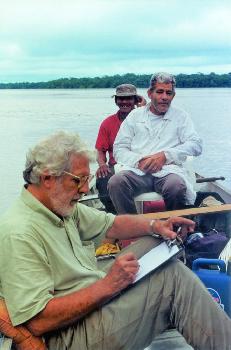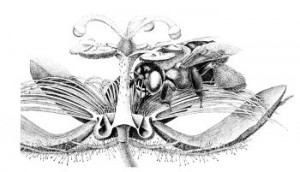
Camargo at the Rio Negro river
Science and art came together for 48 hours in honor of João Maria Franco de Camargo. Friends, fellow researchers and students were undecided as to what was more important: the illustrations produced by his fountain pen with the natural ease of a person writing notes, or the interest and care with which he collected and named bees, the focus of his studies. Camargo created one of the largest and best collections of neotropical Meliponini (stingless bees), which formed his field of expertise. He described three new genera and 86 species, alone or in collaboration with other scientists. Camargo died from lung cancer in September at the age of 68 in the city of Ribeirão Preto, where he had worked at the Biology Department of the College of Philosophy, Sciences, and Letters at the University of São Paulo (FFCLRP/USP).
“Professor João Camargo was Brazil’s leading twentieth century naturalist in our field,” says biologist Vera Lúcia Imperatriz Fonseca, a researcher at USP’s Institute of Advanced Studies and coordinator of a FAPESP-funded theme project on Meliponini bees. This was acknowledged by scientists familiar with his work. “He helped put Ribeirão Preto at the forefront of the places in the world where stingless bees are studied and identified and where students and colleagues can go in search of assistance for research projects on these bees,” wrote Charles Michener, one of the world’s leading experts on this topic. Michener, professor emeritus of Kansas University in the United States, wrote this in a letter sent to USP’s João Atílio Jorge and Carlos Alberto Garófalo when he heard that Camargo had passed away.
The praise takes on further aspects when one becomes acquainted with the professional career of this entomologist, born in the town of Anhembi, São Paulo State. In 1961, Warwick Estevam Kerr, then professor of genetics at the College of Philosophy, Sciences and Letters of Rio Claro, organized a competitive examination to hire an illustrator for the department. “An illustrator is important for biology because photography doesn’t solve everything,” says the 87-year old Kerr, the first scientific director of FAPESP (1962-1964), who is currently working as a collaborating professor at the Federal University of Uberlândia. Camargo was 20 years old when he sat this exam. His drawing of a neotropical stingless bee, the Melipona quadrifasciata, made him its winner.
The illustrator became totally involved in the study of bees and started illustrating the work of the researchers from Rio Claro and later from Ribeirão Preto, where he moved in 1965 when Kerr went to teach at USP. “His illustrations improved my own articles to such an extent that often, to be fair, I included his name as co-author of the study,” says the geneticist. “He was especially important at a time when we lacked the convenience of taking photographs with a microscope,” says Carminda da Cruz Landim, a senior professor from Paulista State University (Unesp) at Rio Claro.
Thanks to his collaboration with Kerr, João Camargo began his bee collection when he went on his first expedition to the Manaus region. The specimens collected in that region, identified by priest Jesus Santiago Moure – renowned as an exceptional taxonomist – were the core of the existing collection, currently based in Ribeirão Preto.

Centris leprieuri: extreme precision of João Maria Franco de Camargo’s drawings
The expeditions throughout Brazil, the bee collection and the publication of his work as a collaborating researcher turned Camargo into a respected scientist without an academic degree. In 1975, however, he was accepted by the entomology master’s degree program at the Federal University of Paraná (UFPR), under the guidance of father Moure. A committee was set up to decide on his qualification to enroll in the program. The committee analyzed his curriculum and granted him an undergraduate degree in biological sciences equivalent to a university degree. Although he had been hired as a technician and did not take an undergraduate course, Camargo obtained a master’s degree (1978) and a PhD (1991). In 1966, he joined the faculty of FFCLRP/USP after passing the exams for this position.
João Camargo’s illustrations illustrate covers and texts of many national and international book editions. In 1972, he organized the Manual de apicultura (Beekeeping Manual), published by Editora Agronômica Ceres. He was advisor to eight master’s degrees, eight PhDs two postdocs. He was also a visiting professor at the Federal University of Maranhão.
Silvia Regina de Menezes Pedro was his constant collaborator. Camargo had been her PhD advisor. The two worked together for the last 21 years at USP in Ribeirão. Silvia is thoroughly familiar with the Camargo Collection. “The collection was expanded during the trips and expeditions he organized to collect specimens. Most of these trips – both in Brazil and abroad – were funded by FAPESP and CNPq; a number of researchers, technicians and former students took part in these expeditions. In addition, he engaged in a great deal of exchange with museums and other scientists,” she says. The entire collection contains about 250 thousand bee specimens. Of these, 150 are of stingless bees of the neotropical Meliponini kind, in particular from the Amazon Region. “This is a unique collection worldwide, and includes 800 bees nests.”
Republish